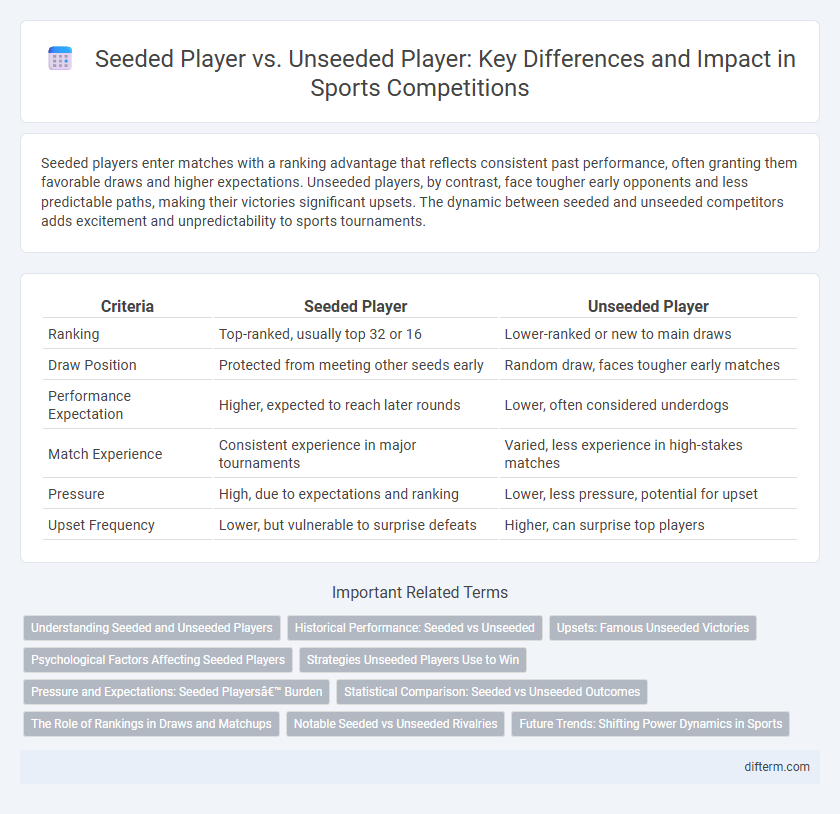Seeded players enter matches with a ranking advantage that reflects consistent past performance, often granting them favorable draws and higher expectations. Unseeded players, by contrast, face tougher early opponents and less predictable paths, making their victories significant upsets. The dynamic between seeded and unseeded competitors adds excitement and unpredictability to sports tournaments.
Table of Comparison
| Criteria | Seeded Player | Unseeded Player |
|---|---|---|
| Ranking | Top-ranked, usually top 32 or 16 | Lower-ranked or new to main draws |
| Draw Position | Protected from meeting other seeds early | Random draw, faces tougher early matches |
| Performance Expectation | Higher, expected to reach later rounds | Lower, often considered underdogs |
| Match Experience | Consistent experience in major tournaments | Varied, less experience in high-stakes matches |
| Pressure | High, due to expectations and ranking | Lower, less pressure, potential for upset |
| Upset Frequency | Lower, but vulnerable to surprise defeats | Higher, can surprise top players |
Understanding Seeded and Unseeded Players
Seeded players are ranked competitors given a favorable position in tournament draws based on their world ranking or past performance, ensuring they avoid facing other top players in early rounds. Unseeded players have no assigned ranking in the tournament, often leading to more challenging matchups against higher-ranked opponents from the start. Understanding the dynamic between seeded and unseeded players highlights the strategic design of tournaments to balance competition and increase the likelihood of top-ranked athletes reaching the later stages.
Historical Performance: Seeded vs Unseeded
Seeded players have historically demonstrated higher win percentages in major tournaments, often advancing to later rounds due to their consistent rankings and past performance. Unseeded players, while less frequent in reaching finals, occasionally create significant upsets, highlighting their potential despite lower rankings. Statistical analysis of Grand Slam events reveals seeded participants dominate quarterfinal and semifinal appearances, underscoring the predictive value of seedings in competitive tennis.
Upsets: Famous Unseeded Victories
Unseeded players have famously upset top seeds in major tournaments, shaking the foundations of expected outcomes and captivating global audiences. Iconic victories like Emma Raducanu's 2021 US Open triumph as a qualifier or Goran Ivanisevic's 2001 Wimbledon win as a wildcard exemplify how unseeded contenders can disrupt rankings and redefine competitive narratives. These landmark upsets highlight the unpredictable nature of sports and the remarkable potential of underdog athletes to achieve historic success.
Psychological Factors Affecting Seeded Players
Seeded players often face intense psychological pressure due to heightened expectations and the fear of underperforming against lower-ranked, unseeded opponents. The stress of maintaining ranking status can lead to increased anxiety and reduced focus, impacting decision-making and overall performance. Mental resilience and effective coping strategies are critical for seeded players to overcome these psychological barriers and succeed against unseeded challengers.
Strategies Unseeded Players Use to Win
Unseeded players often rely on aggressive baseline play combined with variable shot selection to disrupt the rhythm of seeded opponents. They exploit weaknesses by targeting second serves and frequently employ early returns to prevent the higher-ranked player from settling into their preferred patterns. Mental resilience and adaptability to changing match conditions serve as critical strategic assets that unseeded players leverage to overcome ranking disadvantages.
Pressure and Expectations: Seeded Players’ Burden
Seeded players face immense pressure due to high expectations from fans, media, and themselves to perform consistently well in tournaments. This burden often impacts their mental focus and can lead to uncharacteristic errors when facing unseeded opponents. Unseeded players, conversely, benefit from lower expectations, allowing them to play more freely and capitalize on the pressure experienced by their higher-ranked competitors.
Statistical Comparison: Seeded vs Unseeded Outcomes
Statistical analysis of tennis tournaments reveals seeded players win approximately 70% of their matches against unseeded opponents, highlighting a significant performance gap. Seeded players advance to the later rounds, such as quarterfinals or beyond, nearly 60% of the time compared to less than 30% for unseeded players. These statistics underscore the predictive value of seeding based on player rankings and past performance metrics.
The Role of Rankings in Draws and Matchups
Rankings play a crucial role in tournament draws by determining seeded players who receive protection from facing each other in early rounds, allowing a structured progression based on skill level and past performance. Seeded players benefit from this system as it increases their chances of advancing deeper in tournaments by facing lower-ranked or unseeded opponents initially. Unseeded players often face tougher matchups from the start, highlighting the impact of rankings on competitive balance and potential upsets in sports tournaments.
Notable Seeded vs Unseeded Rivalries
Notable seeded versus unseeded rivalries often define the unpredictability and excitement in sports tournaments, highlighting the challenge lower-ranked athletes pose to favorites. Iconic matches such as Rafael Nadal's encounters with unseeded David Ferrer at the French Open illustrate the intensity and skill disparity often overcome in these clashes. These rivalries underscore the dynamic between expected performance based on seedings and the breakthrough potential of underdog competitors.
Future Trends: Shifting Power Dynamics in Sports
Emerging data highlights a rising trend where unseeded players increasingly challenge and upset traditionally dominant seeded players, signaling a shift in competitive balance. Advanced analytics and player development programs contribute to narrowing performance gaps, fostering unpredictable outcomes in major tournaments. This evolving dynamic suggests future sports landscapes will emphasize adaptability and resilience over established rankings.
seeded player vs unseeded player Infographic

 difterm.com
difterm.com